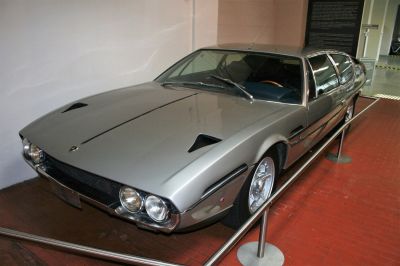 1967 Maserati Ghibli I (AM115) Dimensions, Size & Specs
1967 Maserati Ghibli I (AM115) Dimensions, Size & SpecsMeasurements of the 1967 Maserati Ghibli I, engineered for optimal performance and comfort
| Dimensions | |
|---|---|
| Length: | 4690-4700 mm184.6-185.0 in15.4-15.4 ft |
| Width: | 1790 mm70.5 in5.9 ft |
| Height: | 1160 mm45.7 in3.8 ft |
| Trunk Capacity: | 680 liter24.0 cu ft |
| Weight Specifications | |
| Curb Weight: | 1550-1651 kg3417-3640 lbs |
| Maximal permitted Weight: | 1850-2500 kg4079-5512 lbs |
| Tire Specifications | |
| Rims Sizes: | 15-inch rims:
|
| Tire Size: |
|
The Maserati Ghibli I (AM115), produced between 1967 and 1973, is an iconic Italian grand tourer coupe that combines elegant design with impressive performance. Measuring approximately 4690 to 4700 millimeters in length (about 184.6 to 185.0 inches), 1790 millimeters wide (70.5 inches), and standing at a low height of 1160 millimeters (45.7 inches), the Ghibli I boasts a sleek and aerodynamic profile typical of late 1960s sports cars. Its curb weight ranges from 1550 to 1651 kilograms (3417 to 3640 pounds), reflecting the robust build quality and the combination of luxury and sportiness. The maximum weight the vehicle can handle varies widely between 1850 and 2500 kilograms (4078 to 5512 pounds), depending on configuration and load. One of the highlights for practicality in this coupe is its generously sized luggage compartment, offering up to 680 liters (approximately 24 cubic feet) of storage space, making it suitable for long-distance touring. The Maserati Ghibli I rides on 15-inch rims with a width of 7.5 inches, paired with 215/70 R15 tires, providing a balanced mix of road grip and vintage style. This model epitomizes Maserati's craftsmanship of the era, blending performance, luxury, and functionality in a compact coupe package that remains a cherished classic today.
Discover the standout features that make the 1967 Maserati Ghibli I a leader in its class
Have a question? Please check our knowledgebase first.
The Maserati Ghibli I (AM115) sports coupe has a length ranging between 4690 and 4700 mm (184.6 to 185 inches), a width of 1790 mm (70.5 inches), and a height standing at 1160 mm (45.7 inches). These sleek dimensions contribute to its classic grand tourer profile, providing a low, aerodynamic stance typical of late 1960s design philosophies. The moderate width balances on-road presence with agile handling, while the compact height emphasizes the coupe's sporty character and low center of gravity.
The curb weight of the Maserati Ghibli I ranges from 1550 to 1651 kg (3417 to 3640 pounds), depending on the specific configuration and options installed. Its maximum allowable weight varies significantly, between 1850 and 2500 kg (4078 to 5512 pounds), reflecting variations possibly due to loaded passenger or cargo configurations. The relatively light curb weight for a grand tourer of its era helps the Maserati Ghibli deliver sharp handling and responsive acceleration, while the robust weight capacity ensures the car remains stable and rested during high-speed cruising or load conditions.
The Maserati Ghibli I offers a surprisingly generous luggage capacity of 680 liters (approximately 24 cubic feet). For a two-door grand tourer designed primarily for spirited driving and style, this large trunk space allows for substantial storage, making it suitable for long-distance touring with ample room for luggage. This capacity is notably practical when compared to contemporary sports coupes, giving the Ghibli an edge in blending performance with daily usability and travel convenience.
The original Maserati Ghibli I rides on 15-inch rims sized at 7.5J x 15, which are paired with tires measuring 215/70 R15. These tire dimensions contribute to a balanced blend of ride comfort, grip, and handling precision. The wider 215 mm tire width offers good lateral grip, essential for the car's performance driving nature, while the 70-series sidewall height provides sufficient cushioning to absorb road imperfections. Together, the tire and rim setup was optimized for the grand touring character of the Ghibli, providing stable, confident handling on both winding roads and highways.
Yes, the Maserati Ghibli I generally fits comfortably into a standard modern garage. With a length around 4.69 to 4.7 meters (15.4 to 15.4 feet), width at 1.79 meters (5.9 feet), and height at 1.16 meters (3.8 feet), it occupies a footprint similar to many modern sports coupes, which are designed to accommodate average residential garage sizes of about 6 meters by 3 meters (20 feet by 10 feet). The low height also ensures it fits well under most garage door heights. Owners should, however, measure their specific garage dimensions to allow for comfortable clearance around the vehicle for doors and maneuvering.
The Maserati Ghibli I, launched in 1967, did not have a direct immediate predecessor under the same model name; however, compared to earlier Maserati grand tourers like the Sebring or 5000 GT, the Ghibli was slightly larger and designed to be more aerodynamic and performance-focused. Its length of approximately 4.7 meters (15.4 feet) and its relatively low height made it more modern looking and agile. Compared to competitors like the Ferrari Daytona or Lamborghini Miura of the same era, the Ghibli was similarly sized but tended toward a slightly more understated elegance and a larger luggage capacity, highlighting its grand touring priorities over outright exotic flair.
Compared with similar iconic sports coupes from the late '60s and early '70s, such as the Ferrari 365 GTB/4 Daytona and the Lamborghini Miura, the Maserati Ghibli I falls into a similar dimensional envelope. The Ghibli's length near 4.7 meters (around 185 inches) is comparable to these models, though it is generally wider than many contemporaries at 1.79 meters (70.5 inches), providing a broader stance. Its height of 1.16 meters (45.7 inches) is lower than many sports cars in its class, lending an ultra-sleek profile. Additionally, the Ghibli's generous luggage space stands out, as competitors typically had more limited trunk capacity.
The Maserati Ghibli I's curb weight ranges between 1550 kg (3417 lbs) and 1651 kg (3640 lbs), which was fairly lightweight for a luxurious grand tourer of its time. This relatively low weight enhances overall performance, contributing to brisk acceleration and sharp handling. However, the maximum weight rating varies significantly up to 2500 kg (5512 lbs), though practical loaded weight rarely reaches this upper limit. Fuel efficiency for a vehicle of this era and engine size (typically a V8) would be moderate due to the large engine displacement and relatively heavy components, but the lighter curb weight helps mitigate excessive fuel consumption compared to heavier grand tourers. The balance achieved by its weight also improves cornering stability and responsive driving dynamics.
The Maserati Ghibli I is renowned for its perfect blend of sleek design, size, and practicality. Measuring approximately 4.7 meters in length with a low height of just over 1.1 meters, it offers an elegant and aerodynamic silhouette that was ahead of its time. The width of 1.79 meters gives the car a sporty stance and stability at speed on winding roads, while the sizeable 680-liter luggage compartment offers practicality absent in many other sports coupes. This combination of aggressive proportions, low roofline, and large trunk capacity defines the Ghibli as a true grand tourer, blending style, performance, and utility for long-distance driving comfort.
The Maserati Ghibli I is equipped with 15-inch wheels, sized specifically at 7.5J x 15, complemented by 215/70 R15 tires. This wheel and tire combination was thoughtfully chosen to balance sporty handling and ride comfort. The rim width of 7.5 inches allows for a tire broad enough to ensure good grip, while the 70-series tire aspect ratio maintains some sidewall height, providing cushioning over rough roads. Such an arrangement supports responsive steering and helps the car maintain traction even during spirited driving, while not compromising on ride quality, essential for grand touring.
Discover similar sized cars.

| Production: | 1968-1978 |
|---|---|
| Model Year: | 1968 |
| Length: | 4738 mm186.5 in |
| Width: | 1860 mm73.2 in |
| Height: | 1185 mm46.7 in |
